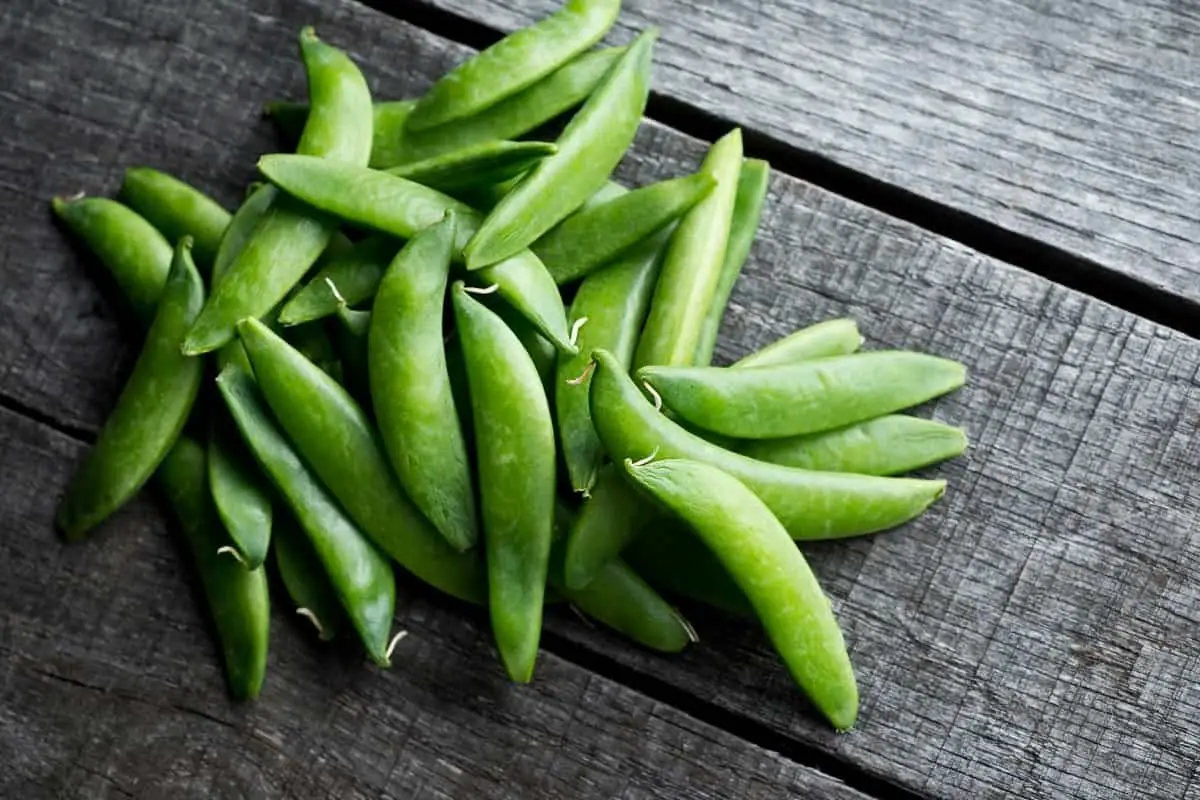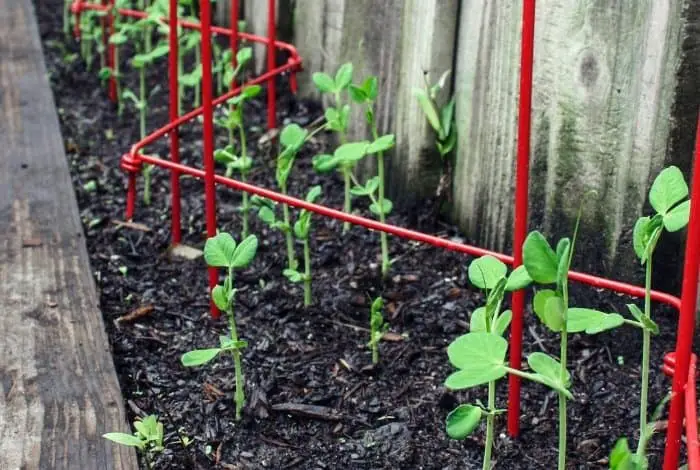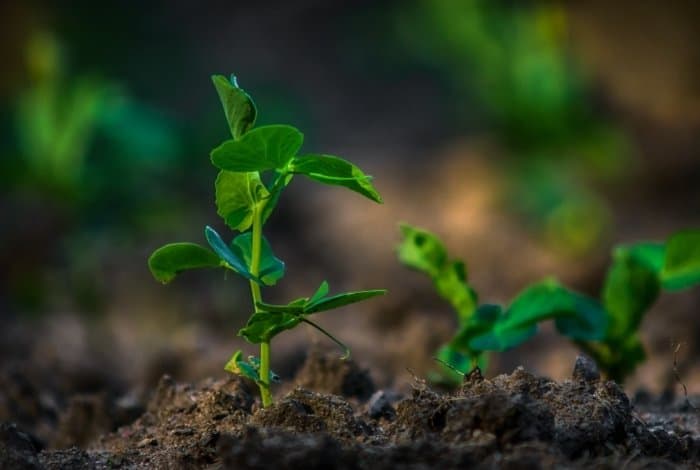Last Updated on January 31, 2023 by Griselda M.
Learning how to grow sugar snap peas in containers is a great way to enjoy the sweet taste of freshly picked sugar snaps. However, taking into consideration the sugar snap peas container size is important. Peas are one of the easiest vegetables to grow in containers. If you have a small garden or space, container gardening is the way to go to maximize the space you have.
Sugar snap peas are a crossbreed between Snow and garden peas. They are the most versatile variety that can either be shelled or used in their pods. They also do very well in container gardens. Homegrown sugar snaps are juicier and sweeter than the ones you buy at the store. This is because you eat them fresh from the garden and can grow organically without any chemicals.
You can grow sugar snaps peas in containers or beds as long as you keep them well watered. A partly sheltered spot giving them a mixture of sun and shade suits them best.
How to Grow Sugar Snap Peas from Seed
Knowing how to grow sugar snap peas from seed will give you delicious-tasting vegetables that you can enjoy. These freshly grown peas are tender and can be incorporated into any meal. They can be eaten raw, steamed, sauteed, or fried when serving. Having a bunch of them growing in your own home or garden would be advantageous in enhancing your daily meals. However, it is essential to look at the sugar snap peas’ container size when growing them in pots.
Here are a few tips for growing sugar snap peas in your garden:
- To begin, ensure that you loosen the soil in your garden during the fall season. This step would allow you to give your sugar snap peas a hard start.
- Ensure that you are using well-drained soil that is rich in the organic matter when planting them. This is because legume plants like sugar snap peas grow best in nutrient-rich growing mediums.
- Incorporating rotted manure or compost into your garden soil is recommended. Ensure that the soil is free of any debris, which includes rocks and dried-out sticks or branches.
- If your garden soil is clay-rich, then to improve drainage and lighten it, you should add some sand. Using a soil test kit to check the pH levels at this stage is advised.
- Amend the soil as recommended to suit your plant. Keep in mind that sugar snap peas are not very demanding when it comes to fertilizing.
- The pea seeds do best when planted after the last spring frost. This is because temperatures usually range between 45 to 75 F during this time.
- Sugasnap peas are not easily susceptible to diseases and insects. But, they should be monitored from time to time to ensure that they are not being invaded.
- Ensure that your plants are always well-watered, especially if rain is scarce.
- Adding mulch around your plant is also beneficial, as it will help retain moisture and prevent weed growth.
Sugar Snap Peas Growing Stages
When it comes to sugar snap peas growing stages, there are a few things that you should look out for. Peas are simple and easy to grow if afforded the right conditions. Although they are not demanding when it comes to certain growing conditions, giving them the best environments, ample water, sugar snap peas container size, and light would aid them in producing abundant yields. Sugar snap peas thrive in soil that is slightly acidic to alkaline. pH levels of around 6.0 to 7.5, which you would find in normal garden soil, are ideal for growing these plants.
Let’s have a look at the sugar snap peas’ growing stages below:
1. Germination Process:
To begin the process of photosynthesis, chlorophyll is used to draw energy from the sunlight. This happens when the sugar snap pea seed starts rooting and produces a vertical shoot for this purpose.
2. Pollination Process:
During this time, the sugar snap pea stems develop flowers and leaves. Flowers play an important role in the development of the plant because they have male and female organs. The female organ is called a style, while the male one is known as the stamen. The stamen contains pollen, while the styles, on the other hand, have the ovary or seed. This makes the plant self-pollinating where you would witness the development of pea pods after the flowers die.
3. Fertilization Process:
After the pollination stage, which is when the pollen reaches the ovary, the fertilization process starts. The pod is then covered by a protective layer or pod for the peas to swell up and grow inside.
4. Dispersal Process:
This process involves harvesting the peas before the plant grows to its full extent. If you don’t pick the peas during this time, chances are that they will become mature and dry up. This would lead to the peas hardening and splitting the pod before falling to the ground and restarting the growing cycle all over again.
How Many Pea Plants per Container
Ever wondered how many pea plants per container? For this reason, sugar snap peas container size should be the first thing that you determine before planting them. When growing peas in pots, they should be planted at least an inch deep. Each plant pot should have between six and eight pea seeds to lend support to each other as they grow. Additionally, if some pea seeds don’t germinate, sowing them thickly would prove fruitful in this case. Planting two seeds in each hole is also good practice in case one fails the germination process.
However, you must keep in mind that once your pea plants start growing, disturbing them is not recommended. This is because they don’t like interference, especially during the root development stages. So, always be careful when you are moving the plant pot around as you could flaw your hard work. Also, make sure that you make use of the best potting soil for peas when growing them in your home.
How Many Sugar Snap Peas per Plant
Aside from sugar snap peas container size, there are other aspects to consider. If you want to know how many sugar snap peas per plant, then depending on the growing conditions, you can expect favorable or unfavorable yields. Although peas are not very big on the production side, you can increase the yield but growing more plants. A food example would be the lot I yielded some time ago. I planted a 40′ row of pea seeds and enjoyed a 104lbs harvest which was great. This was the best production I got while growing sugar snap peas.
When I think about it, I spend a lot of time nurturing my plants and ensuring that their demands were timeously met. This involved soil amendments, sunlight, water requirements, mulching, and much more. It paid off as I enjoyed an abundant yield. So, the number of peas per plant can vary. You can get anything between a quarter to half a pound of peas per plant, depending on the overall growth process.
Choosing the Right Sugar Snap Peas Container
Choosing the right gardening container will help you succeed in growing sugar snaps. Pea plants have a shallow root system; this means they do not grow too deeply into the soil. When choosing a pot to grow your peas, depth is not a necessity but width is. You can therefore grow your sugar snaps in troughs or window boxes.
When choosing a container or pot, make sure it is large enough to hold the plants. Also, ensure it has good drainage holes at the bottom. Clay or terracotta pots dry out quicker than plastic pots. If you choose a shallow pot, get a fast-draining pot that will not keep the roots waterlogged.
Flower Box Planter, Terracotta, 36-Inch
Step-by-Step Guide on How to Grow Sugar Snaps in Containers
Growing peas from seed in containers are easy and quick.
1. Sowing. You can soak the seeds in warm water for 24 hours before sowing. This is to help soften the shell and encourage germination. Sow the seeds 2 inches deep and 2 inches apart. Cover them well and water them.
2. Sunlight. Place the container in a partial sun spot and always keep the soil moist until the seeds germinate.
3. Soil. Use the general-purpose potting mix to plant your seeds.
4. Germination. It will happen within 30 days but in warmer conditions, it can be quicker.
5. Transplanting. This is optional! Some gardeners chose to grow the peas in containers that they will not need to transplant. While others choose to sow on trays and transfer later. Transplant the seedlings when they are about 5 inches tall.
The best time to sow sugar snap peas is in early spring as soon as the last frost date passes. Peas do well in cool weather and they are cultivated the same as those grown in the garden.
Learn how to grow your own food with these tips:
- How To Grow German Butterball Potato
- Squash Growing Tips: How Far Apart to Plant Squash
- How To Grow Portobello Mushrooms From Store Bought
Transplanting the Sugar Snap Peas
Your sugar snap peas are ready to be transplanted when they are about 5 inches long. If you are growing snap peas outside, it is advisable to wait until the last frost date has passed before you plant.
A week before transplanting, stop watering your seedlings. This helps in hardening them in readiness for the different weather outside.
Fill your container with fresh well-draining soil. In this case, we use a commercial potting mix. Plant your sugar snaps 3-4 inches apart.
This is also the best time to place your support – a bamboo pole or trellis in the container. The trellis will provide support for the growing seedlings from an early stage. This will help train the growth of the plant.
Caring for Sugar Snap Peas
Keep the snap peas plants in full sun positions. However, this is with caution! If the sun is too hot, put them under some shade. Too much sun will slow your plants’ growth. Pea plants do well in temperatures ranging between 60 and 75 degrees.
Keep the plants in spots that have good air circulation. Keeping your containers in bright, airy positions encourages healthy growth. The healthier the snap pea plant, the more flowers and pods it gives.
Water the plants to keep the soil moist. Pea plants do not like being waterlogged, do not overwater them. They have a sensitive roots that will rot and die fast. In a warmer climate, you might need to water up to 2 or 3 times a day. Do not allow the soil to dry out water your plants frequently. The topsoil should always feel damp to the touch.
Learn more about Do Plants Like Sugar Water – What Really Happens When You Put Sugar In Plant Soil – Amazing 5 Facts
Growing Peas in Containers- Take-home
You can grow sugar snap peas in containers as an excellent supplement to your vegetables. Pick your snap peas early before the pods are fully swollen. As long as you remember to water regularly, provide support, and harvest on time, they are a low-maintenance food that any gardener can grow! Remember to look for the correct sugar snap peas container size to suit your yield expectations.
FAQs
How many sugar peas does one plant produce?
Sugar peas are typically planted in rows and harvested in a certain period. This is called the sugar harvest. They are planted in rows to make it easier for the workers to pick them. The number of rows, plants, and plantings differs depending on the crop and size of farm, but typical spacing is 12 inches between plants
The average amount of peas that can be harvested from one plant is around 100 pounds of sugar peas per acre.
Many types of sugar peas are traditionally grown from seeds, but some gardeners have started using plants that come from cuttings or clippings. The plant will produce sugars within about three weeks of being planted in soil.
One plant can produce as many as four hundred sugar peas, which is enough to feed a family of four each day for two weeks!
Do sugar snap peas grow well in containers?
The answer to this question is "maybe." Depending on the variety of sugar snap peas, the type of container, and other variables, sugar snap peas may or may not grow well in containers.
Sugar snap peas are a popular garden vegetable that is often grown in containers. However, not many people know how to grow sugar snap peas in containers.
The success of sugar snap pea growing depends on the type of container as well as the amount of light they receive. Most people often plant them in large pots or plastic tubs with holes cut into the bottom for drainage and without any drainage holes at all. However, these types of containers will soon become waterlogged and start rotting your roots
In addition, they require soil that is moist but not wet, so it is important to check the soil every day to make sure that it has enough moisture.
They will do best in a location with at least six hours of direct sunlight. They also need a mild climate with temperatures between 60 and 70 degrees Fahrenheit for the best growth.
So, sugar snap peas are one of the fastest-growing vegetables, so they can do quite well when they’re grown in containers.
How deep should a container be for snap peas?
The depth of a container should be able to accommodate the root system. The container should be deep enough so that the snap peas have room to grow and it should have at least 2-3 inches of space for the roots to grow.
For snap peas, the container size depends on how you want to grow them. The container should be deep enough to allow the pea vines to grow out of the container. The depth of the container will depend on how tall you want your vines to be. If you want them to grow vertically, a container with a depth of 12 inches is perfect. However, if you want them to spread horizontally, a container with a depth of 18 inches is recommended.
Caroline is a gardener who loves to get down to the nitty–gritty of gardening. She proudly proclaims herself as a ‘dirt worshipper‘ and can often be found deep in the garden, covered in soil and singing to her plants. As a self–proclaimed ‘plant whisperer‘, Caroline believes that plants need love and attention just like any other living thing, and she loves to give them both. When she‘s not tending to her garden, you can often find her researching the latest gardening trends, or teaching others how to make their gardens thrive





